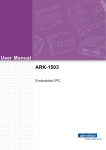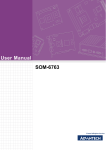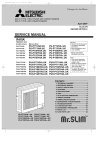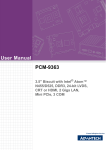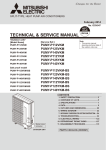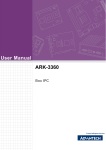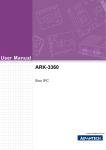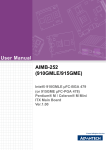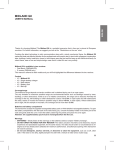Download User Manual ARK-VH200
Transcript
User Manual ARK-VH200 Embedded IPC Attention! Please note: This package contains a hard-copy user manual in Chinese for China CCC certification purposes, and there is an English user manual included as a PDF file on the CD. Please disregard the Chinese hard copy user manual if the product is not to be sold and/or installed in China. ARK-VH200 User Manual ii Copyright The documentation and the software included with this product are copyrighted 2011 by Advantech Co., Ltd. All rights are reserved. Advantech Co., Ltd. reserves the right to make improvements in the products described in this manual at any time without notice. No part of this manual may be reproduced, copied, translated or transmitted in any form or by any means without the prior written permission of Advantech Co., Ltd. Information provided in this manual is intended to be accurate and reliable. However, Advantech Co., Ltd. assumes no responsibility for its use, nor for any infringements of the rights of third parties, which may result from its use. Acknowledgements Award is a trademark of Award Software International, Inc. VIA is a trademark of VIA Technologies, Inc. IBM, PC/AT, PS/2 and VGA are trademarks of International Business Machines Corporation. Intel® and Pentium® are trademarks of Intel Corporation. Microsoft Windows® is a registered trademark of Microsoft Corp. RTL is a trademark of Realtek Semi-Conductor Co., Ltd. ESS is a trademark of ESS Technology, Inc. UMC is a trademark of United Microelectronics Corporation. SMI is a trademark of Silicon Motion, Inc. Creative is a trademark of Creative Technology LTD. CHRONTEL is a trademark of Chrontel Inc. All other product names or trademarks are properties of their respective owners. For more information about this and other Advantech products, please visit our website at: http://www.advantech.com/ http://www.advantech.com/ePlatform/ For technical support and service, please visit our support website at: http://support.advantech.com.tw/support/ Part No. 2006VH2003 Edition 4 Printed in China November 2011 iii ARK-VH200 User Manual Product Warranty (2 years) Advantech warrants to you, the original purchaser, that each of its products will be free from defects in materials and workmanship for two years from the date of purchase. This warranty does not apply to any products which have been repaired or altered by persons other than repair personnel authorized by Advantech, or which have been subject to misuse, abuse, accident or improper installation. Advantech assumes no liability under the terms of this warranty as a consequence of such events. Because of Advantech’s high quality-control standards and rigorous testing, most of our customers never need to use our repair service. If an Advantech product is defective, it will be repaired or replaced at no charge during the warranty period. For outof-warranty repairs, you will be billed according to the cost of replacement materials, service time and freight. Please consult your dealer for more details. If you think you have a defective product, follow these steps: 1. Collect all the information about the problem encountered. (For example, CPU speed, Advantech products used, other hardware and software used, etc.) Note anything abnormal and list any onscreen messages you get when the problem occurs. 2. Call your dealer and describe the problem. Please have your manual, product, and any helpful information readily available. 3. If your product is diagnosed as defective, obtain an RMA (return merchandise authorization) number from your dealer. This allows us to process your return more quickly. 4. Carefully pack the defective product, a fully-completed Repair and Replacement Order Card and a photocopy proof of purchase date (such as your sales receipt) in a shippable container. A product returned without proof of the purchase date is not eligible for warranty service. 5. Write the RMA number visibly on the outside of the package and ship it prepaid to your dealer. Declaration of Conformity FCC Class A Note: This equipment has been tested and found to comply with the limits for a Class A digital device, pursuant to part 15 of the FCC Rules. These limits are designed to provide reasonable protection against harmful interference when the equipment is operated in a commercial environment. This equipment generates, uses, and can radiate radio frequency energy and, if not installed and used in accordance with the instruction manual, may cause harmful interference to radio communications. Operation of this equipment in a residential area is likely to cause harmful interference in which case the user will be required to correct the interference at his own expense. ARK-VH200 User Manual iv Technical Support and Assistance 1. 2. Visit the Advantech web site at www.advantech.com/support where you can find the latest information about the product. Contact your distributor, sales representative, or Advantech's customer service center for technical support if you need additional assistance. Please have the following information ready before you call: – Product name and serial number – Description of your peripheral attachments – Description of your software (operating system, version, application software, etc.) – A complete description of the problem – The exact wording of any error messages Warnings, Cautions and Notes Warning! Warnings indicate conditions, which if not observed, can cause personal injury! Caution! Cautions are included to help you avoid damaging hardware or losing data. e.g. There is a danger of a new battery exploding if it is incorrectly installed. Do not attempt to recharge, force open, or heat the battery. Replace the battery only with the same or equivalent type recommended by the manufacturer. Discard used batteries according to the manufacturer's instructions. Note! Notes provide optional additional information. v ARK-VH200 User Manual Safety Instructions 1. 2. 3. 4. 5. 6. 7. 8. 9. 10. 11. 12. 13. 14. 15. 16. 17. 18. 19. 20. 21. Please read these safety instructions carefully. Please keep this User’s Manual for later reference. Please disconnect this equipment from AC outlet before cleaning. Use a damp cloth. Don’t use liquid or sprayed detergent for cleaning. Use moist sheet or cloth for cleaning. For pluggable equipment, the socket-outlet shall near the equipment and shall be easily accessible. Please keep this equipment from humidity. Lay this equipment on a reliable surface when install. A drop or fall could cause injury. The openings on the enclosure are for air convection hence protecting the equipment from overheating. DO NOT COVER THE OPENINGS. Make sure the voltage of the power source when connecting the equipment to the power outlet. Place the power cord such a way that people cannot step on it. Do not place anything over the power cord. All cautions and warnings on the equipment should be noted. If the equipment is not used for long time, disconnect the equipment from mains to avoid being damaged by transient over-voltage. Never pour any liquid into ventilation openings; this could cause fire or electrical shock. Never open the equipment. For safety reasons, only qualified service personnel should open the equipment. If one of the following situations arises, get the equipment checked by service personnel: The power cord or plug is damaged. Liquid has penetrated into the equipment. The equipment has been exposed to moisture. The equipment does not work well, or you cannot get it to work according to the user's manual. The equipment has been dropped and damaged. The equipment has obvious signs of breakage. DO NOT LEAVE THIS EQUIPMENT IN AN ENVIRONMENT WHERE THE STORAGE TEMPERATURE MAY GO BELOW -40° C (-40° F) OR ABOVE 85° C (185° F). THIS COULD DAMAGE THE EQUIPMENT. THE EQUIPMENT SHOULD BE IN A CONTROLLED ENVIRONMENT. CAUTION: DANGER OF EXPLOSION IF BATTERY IS INCORRECTLY REPLACED. REPLACE ONLY WITH THE SAME OR EQUIVALENT TYPE RECOMMENDED BY THE MANUFACTURER, DISCARD USED BATTERIES ACCORDING TO THE MANUFACTURER'S INSTRUCTIONS. The sound pressure level at the operator's position according to IEC 704-1:1982 is no more than 70 dB (A). RESTRICTED ACCESS AREA: The equipment should only be installed in a Restricted Access Area. DISCLAIMER: This set of instructions is given according to IEC 704-1. Advantech disclaims all responsibility for the accuracy of any statements contained herein. This product is connected to a fuse in a UL listed automotive fuse box in the passenger compartment before it connected to the vehicle battery. Use appropriate, flexible, SAE wiring to connect to the fuse box. ARK-VH200 User Manual vi 22. This product is installed in the passenger compartment. 23. This product must be installed and maintained by qualified service personnel. 24. This device complies with Part 15 of the FCC rules. Operation is subject to the following two conditions: a. this device may not cause harmful interference, and b. this device must accept any interference received, including interference tht may cause undesired operation. Packing List Before installation, please ensure the following items have been shipped: 1 x ARK-VH200 Unit 1 x Driver/Utility CD 1 x Registration and 2 years Warranty card 1 x 3P Phoenix Power PLUG-IN BLOCK 5.0mm Ordering information Model Number Description ARK-VH200A-D5A1E Intel Atom D510 1.66 GHz Compact Embedded Box IPC for Vehicle application, w/ vehicle power, ignition, 4-CH video recorder Optional accessories Part Number Description 1757002682 AC-to-DC Adapter DC19 V/3.42 A 65 W, 0 ~ 40°C for Home and Office Use 1652004519 3P Phoenix Power PLUG-IN BLOCK 5.0mm 1700001524 Power Cable 3-pin 180 cm, USA Type 170203183C Power Cable 3-pin 180 cm, Europe Type 170203180A Power Cable 3-pin 180 cm, UK Type 1700008921 Power Cable 3-pin 180 cm, PSE Mark vii ARK-VH200 User Manual ARK-VH200 User Manual viii Contents Chapter 1 General Introduction ...........................1 1.1 1.2 Introduction ............................................................................................... 2 Product Features....................................................................................... 2 1.2.1 General ......................................................................................... 2 1.2.2 Display .......................................................................................... 3 1.2.3 Ethernet ........................................................................................ 3 1.2.4 Power............................................................................................ 3 1.2.5 Video Recording (ARK-VH200A only) .......................................... 3 Chipset ...................................................................................................... 4 1.3.1 Functional Specifications .............................................................. 4 Mechanical Specifications......................................................................... 6 1.4.1 Dimensions ................................................................................... 6 Figure 1.1 ARK-VH200 Mechanical dimension drawing.............. 6 1.4.2 Weight........................................................................................... 6 Power Requirements................................................................................. 6 1.5.1 System Power............................................................................... 6 1.5.2 RTC Battery .................................................................................. 6 Environmental Specifications .................................................................... 7 1.6.1 Operating Temperature................................................................. 7 1.6.2 Relative Humidity .......................................................................... 7 1.6.3 Storage Temperature.................................................................... 7 1.6.4 Vibration During Operation ........................................................... 7 1.6.5 Shock During Operation................................................................ 7 1.6.6 Safety............................................................................................ 7 1.6.7 EMC .............................................................................................. 7 1.6.8 Vehicle Certifications ................................................................... 7 1.3 1.4 1.5 1.6 Chapter 2 H/W Installation....................................9 2.1 2.2 Introduction ............................................................................................. 10 Jumpers .................................................................................................. 10 2.2.1 Jumper Description ..................................................................... 10 2.2.2 Jumper List ................................................................................. 11 Table 2.1: Jumper List for Motherboard .................................... 11 Table 2.2: Jumper List for MIO Board ....................................... 11 2.2.3 Jumper Locations........................................................................ 11 Figure 2.1 Jumper and connector layout (Motherboard) ........... 11 Figure 2.2 Jumper layout (MIO Board) ...................................... 12 2.2.4 Jumper Setting............................................................................ 12 Connectors.............................................................................................. 15 2.3.1 ARK-VH200 External I/O Connectors ......................................... 15 Figure 2.3 Front panel of ARK-VH200....................................... 15 Figure 2.4 Rear panel of ARK-VH200 ....................................... 15 Figure 2.5 COM Port connector................................................. 16 Table 2.3: COM Connector Pin Assignments............................ 16 Figure 2.6 Ethernet connector ................................................... 16 Table 2.4: Ethernet Connector Pin Assignments....................... 16 Figure 2.7 Audio connector........................................................ 17 Table 2.5: Audio Connector Pin Assignments ........................... 17 Figure 2.8 DIO Connector.......................................................... 17 Table 2.6: DIO Connector Pin Assignments.............................. 17 Figure 2.9 USB connector ......................................................... 18 Table 2.7: USB Connector......................................................... 18 Figure 2.10VGA Connector ........................................................ 18 2.3 ix ARK-VH200 User Manual 2.4 Chapter 3 3.1 3.2 3.3 ARK-VH200 User Manual Table 2.8: VGA Connector Pin Assignments ............................ 18 Figure 2.11Power Input Connector............................................. 19 Table 2.9: Power connector Pin Assignments........................... 19 Figure 2.12Power Button............................................................ 19 Figure 2.13LED Indicators.......................................................... 19 Figure 2.14Power Output Connector.......................................... 19 Table 2.10: Power Output Connector Pin Assignments .............. 20 Figure 2.15eSATA/USB Connector ............................................ 20 Table 2.11: eSATA Connector Pin Assignments......................... 20 Figure 2.16LVDS Connector ...................................................... 20 Table 2.12: LVDS Connector Pin Assignment ............................ 21 Installation............................................................................................... 22 2.4.1 HDD Installation.......................................................................... 22 Figure 2.17Unscrew the HDD door screws ................................ 22 Figure 2.18Assemble HDD and HDD frame with 4 screws ........ 22 Figure 2.19Use the HDD damper screws to assemble the HDD door and HDD frame ................................................ 23 Figure 2.20Connect the HDD cables.......................................... 23 2.4.2 Memory Installation..................................................................... 24 Figure 2.21Install the memory module into the SO-DIMM socket at the bottom of the Main board ................................... 24 2.4.3 CF Card Installation .................................................................... 24 Figure 2.22Unscrew the CF door screws ................................... 24 Figure 2.23Pull the CF tray out................................................... 25 Figure 2.24Remove CF bracket ................................................. 25 Figure 2.25Put CF onto the CF tray ........................................... 26 2.4.4 Wireless Module Installation ....................................................... 26 Figure 2.26Unscrew the top case screws................................... 26 Figure 2.27Knock out ANT hole and screw the SMA Cable into the front panel ................................................................ 27 Figure 2.28Put the SIM card into the socket .............................. 27 Figure 2.29Insert the miniPCIe card module .............................. 28 Figure 2.30Connect the SMA Cable to the miniPCIe card module 28 BIOS Settings .................................... 29 Figure 3.1 Setup Program Initial Screen ................................... 30 Entering BIOS Setup............................................................................... 30 Main Menu .............................................................................................. 31 Figure 3.2 Main Setup Screen................................................... 31 3.2.1 System Time / System Date ....................................................... 31 Advanced BIOS Features Setup............................................................. 31 Figure 3.3 Advanced BIOS Features Setup Screen.................. 32 3.3.1 CPU Configuration...................................................................... 32 Figure 3.4 CPU Configuration Setting ....................................... 32 3.3.2 IDE Configuration ....................................................................... 33 Figure 3.5 IDE Configuration ..................................................... 33 3.3.3 Super I/O Configuration .............................................................. 34 Figure 3.6 Super I/O Configuration............................................ 34 3.3.4 Hardware Health Configuration .................................................. 35 Figure 3.7 Hardware Health Configuration ................................ 35 3.3.5 ACPI Settings ............................................................................. 35 Figure 3.8 ACPI Setting............................................................. 35 Figure 3.9 General ACPI Configuration..................................... 36 Figure 3.10Advanced ACPI Configuration.................................. 36 Figure 3.11Chipset ACPI Configuration ..................................... 37 3.3.6 AHCI Setting ............................................................................... 38 Figure 3.12AHCI Setting............................................................. 38 x 3.3.7 3.4 3.5 3.6 3.7 3.8 APM Configuration...................................................................... 38 Figure 3.13APM Configuration ................................................... 38 3.3.8 Event Log Configuration ............................................................. 39 Figure 3.14Event Log Configuration ........................................... 39 3.3.9 MPS Configuration...................................................................... 40 Figure 3.15MPS Configuration ................................................... 40 3.3.10 Smbios Configuration.................................................................. 41 Figure 3.16Smbios Configuration ............................................... 41 3.3.11 USB Configuration ...................................................................... 41 Figure 3.17USB Configuration.................................................... 41 Figure 3.18USB Mass storage Device Configuration ................. 42 Advanced PCI/PnP Settings ................................................................... 43 Figure 3.19PCI/PNP Setup (top) ................................................ 43 Boot Settings........................................................................................... 44 Figure 3.20Boot Setup Utility ...................................................... 44 3.5.1 Boot Settings Configuration ........................................................ 45 Figure 3.21Boot Setting Configuration........................................ 45 Security Setup......................................................................................... 46 Figure 3.22Password Configuration ........................................... 46 Advanced Chipset Settings ..................................................................... 47 Figure 3.23Advanced Chipset Settings ...................................... 47 3.7.1 North Bridge Chipset Configuration ............................................ 47 Figure 3.24North Bridge Configuration ....................................... 47 Figure 3.25Video function configuration ..................................... 48 3.7.2 South Bridge Chipset Configuration............................................ 49 Figure 3.26South Bridge Configuration ...................................... 49 Exit OS .................................................................................................... 50 Figure 3.27Exit Option ................................................................ 50 3.8.1 Save Changes and Exit .............................................................. 50 3.8.2 Discard Changes and Exit .......................................................... 50 3.8.3 Load Optimal Defaults ................................................................ 50 3.8.4 Load Fail-Safe Defaults .............................................................. 50 xi ARK-VH200 User Manual ARK-VH200 User Manual xii Chapter 1 1 General Introduction This chapter gives background information on ARK-VH200 series. 1.1 Introduction The ARK-VH200 fanless Embedded Industrial Computer is an ideal, applicationready system platform solution for in-vehicle applications. All electronics are protected in a compact, sealed, aluminum case for easy embedding in the customer's own housing, or as a stand-alone application where space is limited and the environment harsh. A solid sealed aluminum case provides vibration and dust resistance while also providing a passive cooling solution. The ARK-VH200 provides system integrators with a turn-key solution and versatile application development path without breaking the bank or missing time-to-market deadlines. The ARK-VH200 can be used as a standalone system in vehicles, and occupies a footprint of only 260 x 134 x 77 mm. The rugged, cast aluminum case not only provides great protection from EMI, shock/vibration, cold and heat, but, as we mentioned before, passive cooling for quiet, fanless operation. Its particular power design accepts a wide range of DC power that is compliant with vehicle power. ARK-VH200 is able to power ON/OFF with the ignition status of vehicles through the ignition pin. The firmware in ARK-VH200 is designed for controlling turn-on delay, turn-off delay and hard off, which ensures the system works dependably even in the vehicular electrical environment. The ARK-VH200 answers offers up to 1 x VGA, 5 x USB 2.0 ports, 3 x Giga LAN ports, 3 x COM ports, 1 x eSATA, on board GPS, and 4-bit GPIO. Besides, ARKVH200 can also support either 4 channel video recorders with H.264 hardware decoding or one PoE interface. The ARK-VH200 Compact Embedded Computer supports both 2.5" SATA HDD and Compact Flash card for storage options; it provides not only for in-vehicle use, but also for diversified applications in other fields. 1.2 Product Features 1.2.1 General CPU: Intel® AtomTM Processor D510 1.6 GHz System Chipset: Intel® ICH8M BIOS: AMI 16 Mbit Flash BIOS System Memory: DDRII 667 MHz up to 2 GB SSD: Supports CompactFlash Card TYPE I/II Watchdog Timer: Single chip Watchdog 255-level interval timer, setup by software I/O Interface: 3 x RS232 USB: 5 x USB 2.0 (one shared with e-SATA connector), Compliant with USB 2.0, two ports with lock Audio: Line out, Mic-in DIO: 4-bit general purpose input/output Expansion Interface: Supports 2 x Mini-PCIe device eSATA: Supports 1 x eSATA (not support hot plug) GPS: Built-in u-blox LEA 5 GPS GPS/GALILEO chip (Communication via COM4) Video Recording: Supports 4 x CH Video and Audio input with HW cording. ARK-VH200 User Manual 2 1.2.3 Ethernet Chipset: LAN1 Intel 82567, LAN2 Intel 82583V, PoE Intel 82574L (ARKVH200B only) Speed: 10/100/1000 Mbps Interface: 3 x RJ45 Standard: Compliant with IEEE 802.3, IEEE 802.3u, IEEE 802.3x, IEEE 802.3y, IEEE 802.ab. Power over Ethernet: Compliant with IEEE802.3 af, up to 15 Watt (ARKVH200B only) 1.2.4 Power Input Voltage: PC Mode: 9 VDC ~ 32 VDC; VH Mode: 12 V battery (11 VDC ~ 16 VDC), 24V battery (22 VDC ~ 32 VDC) Ignition: Support ignition function In-Vehicle Function: Battery status check, and Off-delay support In-Vehicle Certificate: Compliant with ISO-7637-2 Input Connector Interface: 3-pin phoenix connector (pitch 5.0mm) Power Output: 12VDC maximum 1A and 5VDC maximum 1A 1.2.5 Video Recording (ARK-VH200A only) Video Compression: H/W H.264 Video Input: 4 x Ch Video Inputs, BNC Audio Input: 4 x Ch Audio Inputs, D-SUB9 (Optional) Video Format: CIF, 2CIF, D1 Video Frame: 30/25 FPS (NTSC/PAL) @ D1 resolution Watchdog Timer: Yes SDK Support: VC++, .NET/BCB/VB 3 ARK-VH200 User Manual General Introduction Chipset: Intel® Embedded Gen3.5+ GFX Core Memory Size: Up to 224 MB of dynamic video memory allocation Interface: – CRT x 1 – LVDS: Supports 18-bit LVDS LCD Resolution: – CRT: to 2048 x 1536 (CRT single display) – LVDS: Single channel 18-bit LVDS up to WXGA 1366 x 768 Dual Display: – CRT + LVDS (18-bit) Chapter 1 1.2.2 Display 1.3 Chipset 1.3.1 Functional Specifications 1.3.1.1 Processor Processor Intel® AtomTM D510 at 1.67 GHz with 1MB L2 cache Manufacturing Technology: 45 nm 1.3.1.2 Chipset Memory Intel® D510 Supports DDR2 667 MHz up to 2 GB SODIMM Socket: – 1* 200-pin SODIMM socket type *1 Graphic and Video Controllers Intel 3.5 Gen Integrated Graphic Engine + GFX core DVMT 3.0 (Dynamic Video Memory Technology) DirectX* 9 compliant Pixel Shader 2.0 Dual display choose on board: VGA, LVDS or VGA + LVDS through OS Driver Intel® Clear Video Technology VGA: Intel Atom D510 supports up to 2048 x 1536 (VGA single display) LVDS: Single channel 18-bit LVDS up to WXGA 1366 x 768 VGA Connector on board: D-SUB 15P LVDS Connector: MDR-26P SATA & IDE Interface SB: Intel® ICH8M chip supports: Supports the Serial ATA specification Revision 1.0a Supports several optional sections of Serial ATA II: Extensions to Serial ATA 1.0 Specification, Revision 1.0 Supports SATA transfers to 300 Mbytes/sec. Supports Compact Flash Card Type II Socket CF Socket: CF Type II 50P 90D(M) external connector x 1 USB Interface SB: Intel® ICH8M chip supports: USB host interface with support for 6 USB 2.0 ports All ports are High-Speed, Full-Speed, and Low-Speed capable Supports legacy keyboard/mouse software Audio Link SB: Intel® ICH8M chip supports: Supports HD Codec Supports Link for Audio and Telephony CODECS Power Management SB: Intel® ICH8M chip supports: Supports ACPI 2.0 ACPI Power Management Logic Support BIOS SB: Intel® ICH8M chip supports: AMI 16Mb Flash BIOS via SPI ARK-VH200 User Manual 4 LAN SMSC SCH 3114 support 3 serial ports by SMSC SCH 3114. High Speed NS16C550A Compatible UARTs with Data rates to 1.5Mbps. Support IRQ Sharing among serial ports on XPE COM1~COM3: Supports RS-232 COM connector: D-SUB CON. 9P Audio Audio Codec: Realtek ALC888: Compliant with HD Audio specifications Supports to 16/20/24-bit DAC and 16/20/24-bit ADC resolution Support: Line-out, Mic-in Audio Connectors: Ear Phone Jack * 2 DIO SMSC SCH 3114 support 5 I/O pins with one ground pin 5V tolerance I/Os. DIO Connector: 5-pin Phoenix connector Battery backup BATTERY 3V/210 mAh with WIRE x 1 5 ARK-VH200 User Manual General Introduction Serial ports LAN1 Intel 82567, LAN2 Intel 82583V Compliant with IEEE 802.3, IEEE 802.3u, IEEE 802.3x, IEEE 802.3y, IEEE 802.ab. Support 1000 Mbps. LAN Connectors: Phone Jack RJ45 8P 90D(F) Chapter 1 1.3.1.3 Other 1.4 Mechanical Specifications 1.4.1 Dimensions 220 x 85 x 130 Unit: mm 260.0 11.0 R3.0 76.9 134.0 159.1 95.2 134.0 119.0 A 19.4 17.8 216.5 14 10 3 2.5 8 4 R2.5 R2 R4 1.09 3.09 DETAIL A SCALE 2 : 1 238.0 260.0 Unit: mm Figure 1.1 ARK-VH200 Mechanical dimension drawing 1.4.2 Weight 3 kg (6.6 lb) 1.5 Power Requirements 1.5.1 System Power Minimum power input: DC9V-32V 6A-1.7A 1.5.2 RTC Battery Lithium 3 V/210 mAH ARK-VH200 User Manual 6 1.6.1 Operating Temperature With Industrial Grade CompactFlash disk: 0 ~ 60° C (32~131° F), when air flow speed = 0.7 m/sec With 2.5-inch extended temperature hard disk 0 to 45° C (32~113° F), when air flow speed = 0.7 m/sec 95% @ 40° C (non-condensing) 1.6.3 Storage Temperature -40 ~ 85° C (-40 ~ 185° F) 1.6.4 Vibration During Operation When system is equipped with Compact Flash card only: 5Grms, IEC 60068-264, random, 5 ~ 500 Hz, 1 Oct/min., 1hr/axis, x,y,z 3 axes. When system is equipped with 2.5-inch HDD: 1Grms, IEC 60068-2-64, random, 5~500 Hz, 1 Oct/min., 1hr/axis, x,y,z 3 axes. 1.6.5 Shock During Operation When system is equipped with Compact Flash card only: 50G, IEC 60068-2-27, half sine, 11 ms duration. When system is equipped with 2.5-inch: 20G, IEC 60068-2-27, half sine, 11 ms duration. 1.6.6 Safety CCC 1.6.7 EMC 1.6.8 CE, FCC, CCC Vehicle Certifications eMark, EN-5015 7 ARK-VH200 User Manual General Introduction 1.6.2 Relative Humidity Chapter 1 1.6 Environmental Specifications ARK-VH200 User Manual 8 Chapter 2 2 H/W Installation This chapter introduces external IO and the installation of ARK-VH200 hardware. 2.1 Introduction The following sections show the internal jumper settings and the external connectors and pin assignments for applications. 2.2 Jumpers 2.2.1 Jumper Description You may configure the ARK-VH200 to match the needs of your application by setting jumpers. A jumper is a metal bridge used to close an electric circuit. It consists of two metal pins and a small metal clip (often protected by a plastic cover) that slides over the pins to connect them. To close a jumper, you connect the pins with the clip. To open a jumper, you remove the clip. Sometimes a jumper will have three pins, labeled 1, 2 and 3. In this case you would connect either pins 1 and 2, or 2 and 3. open closed closed 2-3 The jumper settings are schematically depicted in this manual as follows. 1 2 open 1 2 closed closed 2-3 A pair of needle-nose pliers may be helpful when working with jumpers. If you have any doubts about the best hardware configuration for your application, contact your local distributor or sales representative before you make any changes. Generally, you simply need a standard cable to make most connections. ARK-VH200 User Manual 10 Chapter 2 2.2.2 Jumper List Table 2.1: Jumper List for Motherboard J2 COM2 Setting J4 Clear CMOS J5 Panel Voltage Select JP2 Mini PCI-E Power Setting Header CN2 Antenna IPEX Connector for GPS CN3 COM for GPS H/W Installation Table 2.2: Jumper List for MIO Board 2.2.3 Jumper Locations Motherboard CN5 CN1 CN2 CN6 CN3 CN4 CN7 CN8 CN9 J4 CN11 CN14 J5 CN20 BH1 CN24 CN25 CN15 CN17 CN26 CN12 J2CN27 CN16 Figure 2.1 Jumper and connector layout (Motherboard) 11 ARK-VH200 User Manual MIO Board CN10 CN22 CN18 CN31 CN19 CN17 CN21 CN28 CN29 CN30 SW1 CN20 CN32 CN15 CN23 CN2 CN3 CN12 CN11 CN25 JP2 CN33 CN5 CN24 D21 CN6 CN7 CN8 CN9 D23 Figure 2.2 Jumper layout (MIO Board) 2.2.4 Jumper Setting Motherboard J4 CLEAR CMOS Part Number 1653003101 Footprint HD_3x1P_79_D Description PIN HEADER 3*1P 180D(M) DIP SQUARE W/O Pb Setting Function (1-2) NORMAL (Default) (2-3) CLEAR CMOS ARK-VH200 User Manual 12 Internal LVDS PANEL POWER Select Part Number 1653003101 Footprint HD_3x1P_79_D Description PIN HEADER 3*1P 180D(M) 2.0mm DIP SQUARE W/O Pb Setting Function (1-2) 5 V for LVDS PANEL POWER (2-3) 3.3 V for LVDS PANEL POWER (Default) Chapter 2 J5 H/W Installation MIO Board JP2 Mini PCI-E Power Setting Header Part Number 1653003100 Package PH3x1P-2.54 Description PIN HEADER 3*1P 180D(M) 2.54mm DIP WO/Pb Setting Function 1-2 +V3.3SB (Default) 2-3 +V3.3V 13 ARK-VH200 User Manual CN2 Antenna IPEX connector for GPS Part Number 1654004676 Package RF_3P Description RF Conn 3p 180D(M) SMD 105A01-000000-G4 Pin Name 1 GND_GPS 2 GPS_RFIN 3 GND_GPS CN3 COM for GPS Part Number 1655303020 Package WHL3V-2M Description WAFER BOX 2.0mm 3P 180D w/LOCK Pin Name 1 RXD2 2 TXD2 3 GND ARK-VH200 User Manual 14 2.3.1 ARK-VH200 External I/O Connectors ANT Audio in (optional) CH 1 CH 2 GPS LED CH 3 CH 4 ANT LED HDD LED Power On/Off PC/Vehicle Mode VGA Figure 2.3 Front panel of ARK-VH200 Power On/Off GPS ANT Line out MIC PoE USB3 COM 2 USB2 ESATA DC OUT DIO LVDS COM 3 Figure 2.4 Rear panel of ARK-VH200 15 ARK-VH200 User Manual H/W Installation USB 0 LAN 1 LAN 2 USB 1 CF COM 1 CARD ANT Chapter 2 2.3 Connectors 2.3.1.1 COM Connector ARK-VH200 provides three D-sub 9-pin connectors. 1 2 3 4 5 6 7 8 9 Figure 2.5 COM Port connector Table 2.3: COM Connector Pin Assignments RS-232 Pin Signal Name 1 DCD 2 RxD 3 TxD 4 DTR 5 GND 6 DSR 7 RTS 8 CTS 9 RI 2.3.1.2 Ethernet Connector (LAN) ARK-VH200 is equipped with up to three Ethernet controllers that are fully compliant with IEEE 802.3u 10/100/1000 Mbps CSMA/CD standards. LAN1 is equipped with 82567; LAN2 is equipped with 82583V. The Ethernet port provides a standard RJ-45 jack connector with LED indicators on the front side to show its Active/Link status (Green LED) and Speed status (Green/Yellow LED). 8 1 Figure 2.6 Ethernet connector Table 2.4: Ethernet Connector Pin Assignments Pin 10/100/1000BaseT Signal Name 1 TX+ 2 TX- 3 RX+ 4 MDI2+ 5 MDI2- 6 RX- 7 MDI3+ 8 MDI3- ARK-VH200 User Manual 16 1 2 Table 2.5: Audio Connector Pin Assignments Pin Audio Signal Name 1 Mic_In 2 Line_Out 2.3.1.4 DIO Connector ARK-VH200 provides one phoenix 5-pin male connector which serves as a Digital Input/Output communication interface. If the client wants to use DIO, pin assignments are as follows. Figure 2.8 DIO Connector Table 2.6: DIO Connector Pin Assignments Pin Signal Name 1 DIO bit0 2 DIO bit1 3 DIO bit2 4 DIO bit3 5 GND 2.3.1.5 USB Connector ARK-VH200 provides four USB interface connectors, which give complete Plug & Play and hot swapping for up to 127 external devices. The USB interface complies with USB UHCI, Rev. 2.0. The USB interface can be disabled in the system BIOS setup. Please refer to Table. 2.7 for its pin assignments. The USB connectors are used to connect any device that conforms to the USB interface. Most digital devices conform to this standard. The USB interface supports Plug and Play without turning off computers. Note that USB2 and USB3 are lockable USB connectors. When any 17 ARK-VH200 User Manual H/W Installation Figure 2.7 Audio connector Chapter 2 2.3.1.3 Audio Connector ARK-VH200 offers two stereo audio ports, each with a phone jack connector: Mic_In and Line_Out. The audio is controlled by ALC888, and it's compliant with Azalea standard. USB device is plugged into either of these two connectors, it locks into place. Release the latch plate above the USB2/3 connector to un-plug the USB device. Figure 2.9 USB connector Table 2.7: USB Connector Pin Signal name Pin Signal name 1 VCC 2 USB_data- 3 USB_data+ 4 GND 2.3.1.6 VGA Connector The ARK-VH200 provides a high resolution VGA interface connected by a D-sub 15pin connector to support a VGA CRT monitor. It supports display resolutions up to 2048 x 1536. Figure 2.10 VGA Connector Table 2.8: VGA Connector Pin Assignments Pin Signal Name Pin Signal Name 1 Red 2 Green 3 Blue 4 NC 5 GND 6 GND 7 GND 8 GND 9 NC 10 GND 11 NC 12 NC 13 H-SYNC 14 V-SYNC 15 NC 2.3.1.7 Power Input Connector ARK-VH200 comes with a three-pin header that carries 9~32 VDC external power input. For the in-vehicle power mode, there is one pin for the ignition signal. For the PC ATX mode, the ignition pin can be ignored. ARK-VH200 User Manual 18 Chapter 2 1 2 3 Figure 2.11 Power Input Connector Table 2.9: Power connector Pin Assignments Signal Name 1 Ignition (> 9VDC) 2 GND 3 PC Mode: 9 VDC ~ 32 VDC VH Mode: 12 V battery (11 VDC ~ 16 VDC), 24V battery (22 VDC ~ 32 VDC) 2.3.1.8 Power ON/OFF Button ARK-VH200 comes with a Power On/Off button with LED indicators on the front side to show its On status (Green LED) and Off/Suspend status (Orange LED). Dual functions of Soft Power -On/Off (Instant off or Delay 4 Second), and Suspend are supported. Figure 2.12 Power Button 2.3.1.9 LED Indicators There are two LED indicators on ARK-VH200 front panel for indicating system status: GPS LED will flash when it receive GPS signal from satellites; and WLAN LED will flash when it retrieval the data. Figure 2.13 LED Indicators 2.3.1.10 Power Output Connector ARK-VH200 comes with a 4-pin Power Output Connector to provide 5 VDC and 12 VDC power. This power can be use for a panel or other peripherals, but neither should exceed 1A current. 1 2 3 4 Figure 2.14 Power Output Connector 19 ARK-VH200 User Manual H/W Installation Pin Table 2.10: Power Output Connector Pin Assignments Pin Signal Name 1 GND 2 GND 3 +5VDC 4 +12VDC 2.3.1.11 eSATA/USB Connector ARK-1382 provides an external SATA connector for external storage; if you do not need to use eSATA, the connector can be used as a USB port. 4 3 2 1 5 6 7 8 9 10 11 Figure 2.15 eSATA/USB Connector Table 2.11: eSATA Connector Pin Assignments Pin Signal Name 1 VBUS 2 D- 3 D+ 4 GND 5 GND 6 SATA_TX+ 7 SATA_TX- 8 GND 9 SATA_RX- 10 SATA_RX+ 11 GND 2.3.1.12 LVDS Connector The ARK-LVDS comes with a D-Sub 26-pin connector that carries LVDS signal output, and can direct-connect to LVDS LCD display via external cable. The system also provides a jumper (J5) on the motherboard for selecting the LCD signal power of 5V or 3.3V, please refer to Section 2.2.2 for the jumper table of J5. The default setting for J5 is for 5V. Figure 2.16 LVDS Connector ARK-VH200 User Manual 20 Signal Name Pin Signal name 1 NC 14 NC 2 GND 15 A0M 3 A0P 16 A1M 4 A1P 17 A2M 5 A2P 18 CLK1M 6 CLK1P 19 GND 7 VCC_LCD 20 VDD_LCD 8 GND 21 NC 9 NC 22 NC 10 NC 23 NC 11 NC 24 NC 12 NC 25 NC 13 NC 26 GND 21 H/W Installation Pin Chapter 2 Table 2.12: LVDS Connector Pin Assignment ARK-VH200 User Manual 2.4 Installation 2.4.1 HDD Installation 1. 1.Unscrew the HDD door screws on the bottom side of ARK-VH200. Figure 2.17 Unscrew the HDD door screws 2. Assemble HDD in the HDD frame with four screws. Figure 2.18 Assemble HDD and HDD frame with 4 screws ARK-VH200 User Manual 22 Use the HDD damper screws to assemble the HDD door and HDD frame. 4. Connect the HDD cables. Figure 2.20 Connect the HDD cables 5. Replace HDD door and secure with screws. 23 ARK-VH200 User Manual H/W Installation Figure 2.19 Use the HDD damper screws to assemble the HDD door and HDD frame Chapter 2 3. 2.4.2 Memory Installation 1. 2. Refer to section 2.4.1-1 to open the HDD door. Install the memory module into the SODIMM socket at the bottom of the main board. Figure 2.21 Install the memory module into the SO-DIMM socket at the bottom of the Main board 3. Replace HDD door and secure with screws. 2.4.3 CF Card Installation 1. Unscrew the CF door screws. Figure 2.22 Unscrew the CF door screws ARK-VH200 User Manual 24 Pull the CF tray out. Chapter 2 2. H/W Installation Figure 2.23 Pull the CF tray out 3. Remove the black CF bracket. Figure 2.24 Remove CF bracket 25 ARK-VH200 User Manual 4. Put CF on to the CF tray. Figure 2.25 Put CF onto the CF tray 5. Push the CF tray back and secure with screws. 2.4.4 Wireless Module Installation 1. Unscrew screws of ARK-VH200 top case, and open it. Figure 2.26 Unscrew the top case screws ARK-VH200 User Manual 26 Remove the ANT hole knockout and screw the SMA Cable into the front panel. The knockout beside the HDD LED is suggested for the miniPCIe device, if any, on the MIO board. The corresponding knockout on the back panel is suggested for the miniPCIe device, again if any, on the bottom of the motherboard. Chapter 2 2. H/W Installation Figure 2.27 Knock out ANT hole and screw the SMA Cable into the front panel 3. Put the SIM card into the socket if needed. (Only the miniPCIe on the MIO board can support a SIM card.) Figure 2.28 Put the SIM card into the socket 27 ARK-VH200 User Manual 4. Insert the miniPCIe card module and screw it onto the socket. Figure 2.29 Insert the miniPCIe card module 5. Connect the SMA Cable to the miniPCIe card module. Figure 2.30 Connect the SMA Cable to the miniPCIe card module 6. Replace top case cover and secure the screws. ARK-VH200 User Manual 28 Chapter 3 3 BIOS Settings This chapter introduces how to set BIOS configuration data. AMIBIOS has been integrated into many motherboards for over two decades. With the AMIBIOS Setup program, you can modify BIOS settings and control the various system features. This chapter describes the basic navigation of the ARK-VH200 BIOS setup screens. Figure 3.1 Setup Program Initial Screen AMI’s BIOS ROM has a built-in Setup program that allows users to modify the basic system configuration. This information is stored in battery-backed CMOS so it retains the Setup information when the power is turned off. 3.1 Entering BIOS Setup Turn on the computer and check for the “patch code”. If there is a number assigned to the patch code, it means that the BIOS supports your CPU. If there is no number assigned to the patch code, please contact an Advantech application engineer to obtain an up-to-date patch code file. This will ensure that your CPU’s system status is valid. After ensuring that you have a number assigned to the patch code, immediately press <DEL> and you will enter Setup. ARK-VH200 User Manual 30 When you first enter the BIOS Setup Utility, you will enter the Main setup screen. You can always return to the Main setup screen by selecting the Main tab. There are two Main Setup options. They are described in this section. The Main BIOS Setup screen is shown below. Chapter 3 3.2 Main Menu BIOS Settings Figure 3.2 Main Setup Screen The Main BIOS setup screen has two main frames. The left frame displays all the options that can be configured. Grayed-out options cannot be configured; options in blue can. The right frame displays the key legend. Above the key legend is an area reserved for a text message. When an option is selected in the left frame, it is highlighted in white. Often a text message will accompany it. 3.2.1 System Time / System Date Use this option to change the system time and date. Highlight System Time or System Date using the <Arrow> keys. Enter new values through the keyboard. Press the <Tab> key or the <Arrow> keys to move between fields. The date must be entered in MM/DD/YY format. The time must be entered in HH:MM:SS format. 3.3 Advanced BIOS Features Setup Select the Advanced tab from the ARK-VH200 setup screen to enter the Advanced BIOS Setup screen. You can select any of the items in the left frame of the screen, such as CPU Configuration, to go to the sub menu for that item. You can display an Advanced BIOS Setup option by highlighting it using the <Arrow> keys. All Advanced BIOS Setup options are described in this section. The Advanced BIOS Setup screens is shown below. The sub menus are described on the following pages. 31 ARK-VH200 User Manual Figure 3.3 Advanced BIOS Features Setup Screen 3.3.1 CPU Configuration Figure 3.4 CPU Configuration Setting Max CPUID Value Limit This item allows you to limit CPUID maximum value. Execute-Disable Bit Capability This item allows you to enable or disable the No-Execution page protection technology. Hyper Threading Technology This item allows you to enable or disable Intel® Hyper Threading technology. ARK-VH200 User Manual 32 Intel® SpeedStep® Tech When set to disabled, the CPU runs at its default speed, when set to enabled, the CPU speed is controlled by the operating system. Intel® C-STATE tech This item allows the CPU to save more power under idle mode. Enhanced C-States CPU idle set to enhanced C-States, disabled by Intel® C-STATE tech item. BIOS Settings 3.3.2 IDE Configuration Figure 3.5 IDE Configuration Chapter 3 ATA/IDE Configuration This item allows you to select Disabled / Compatible / Enhanced. Legacy IDE Channels When set to Enhanced mode you can select IDE or AHCI mode. When select Compatible mode you can select SATA only / SATA pri, PATA sec or PATA only. Primary/Secondary/Third IDE Master/Slave BIOS auto detects the presence of IDE device, and displays the status of auto detection of IDE device. – Type: Select the type of SATA driver.[Not Installed][Auto][CD/DVD][ARMD] – LBA/Large Mode: Enables or Disables the LBA mode. – Block (Multi-Sector Transfer): Enables or disables data multi-sectors transfers. – PIO Mode: Select the PIO mode. – DMA Mode: Select the DMA mode. – S.M.A.R.T.: Select the smart monitoring, analysis, and reporting technology. – 32Bit Data Transfer: Enables or disables 32-bit data transfer. Hard Disk Write Protect Disable/Enable device write protection. This will be effective only if device is accessed through BIOS. 33 ARK-VH200 User Manual IDE Detect Time Out (Sec) This item allows you to select the time out value for detecting ATA/ATAPI device(s). 3.3.3 Super I/O Configuration Figure 3.6 Super I/O Configuration Serial Port1 / Port2 / Port3 / Port 4 address (Port 4 is for GPS communication) This item allows you to select serial port1 ~ port4 of base addresses. Serial Port1 / Port2 / Port3 / Port 4 IRQ (Port 4 is for GPS communication) This item allows you to select serial port1 ~ port4 of IRQ. Parallel Port Address (optional) This item allows you to select Parallel port address. Parallel Port Mode (optional) This item allows you to select Parallel port Mode. Parallel Port IRQ (optional) This item allows you to select Parallel port IRQ. RS-485 Control for SP2 This item allows you to select RS485 control. Auto Direction Control Select This item allows you to enable or disable auto flow control function. ARK-VH200 User Manual 34 Chapter 3 3.3.4 Hardware Health Configuration BIOS Settings Figure 3.7 Hardware Health Configuration H/W Health Function This item allows you to control H/W monitor of showing. Temperature & Voltage Show CPU/System Temperature Vcore / +3.3 Vin / +5 Vin / +12 Vin / VBAT 3.3.5 ACPI Settings Figure 3.8 ACPI Setting 35 ARK-VH200 User Manual 3.3.5.1 General ACPI Configuration Figure 3.9 General ACPI Configuration Suspend Mode Select the ACPI state used for system suspend. Report Video on S3 Resume This item allows you to invoke VA BIOS POST on S3/STR resume. 3.3.5.2 Advanced ACPI Configuration Figure 3.10 Advanced ACPI Configuration ARK-VH200 User Manual 36 3.3.5.3 Chipset ACPI Configuration Figure 3.11 Chipset ACPI Configuration Energy Lake Feature Allows you to configure Intel's Energy Lake power management technology. APIC ACPI SCI IRQ Enable/Disable APIC ACPI SCI IRQ. USB Device Wakeup From S3/S4 Enable/Disable USB Device Wakeup from S3/S4. High Performance Event Timer Enable/Disable High performance Event timer. 37 ARK-VH200 User Manual BIOS Settings ACPI Version Features This item allows you to enable RSDP pointers to 64-bit fixed system description tables. ACPI APIC support Include APIC table pointer to RSDT pointer list. AMI OEMB table Include OEMB table pointer to R(x)SDT pointer lists. Headless mode Enable / Disable Headless operation mode through ACPI. Chapter 3 3.3.6 AHCI Setting Figure 3.12 AHCI Setting AHCI Port0 / Port While entering setup, BIOS auto detects the presence of IDE devices. This displays the status of auto detection of IDE device. 3.3.7 APM Configuration Figure 3.13 APM Configuration ARK-VH200 User Manual 38 3.3.8 Event Log Configuration Figure 3.14 Event Log Configuration 39 ARK-VH200 User Manual BIOS Settings Power Management/APM Enable or disable APM. Power Button Mode Power on, off, or enter suspend mode when the power button is pressed. The following options are also available. Restore on AC power Loss Use this to set up the system response after a power failure. The "Off" setting keeps the system powered off after power failure, the "On" setting boots up the system after failure, and the "Last State" returns the system to the status just before power failure. Video Power Down Mode Power down video in suspend or standby mode. Hard Disk Power Down Mode Power down Hard Disk in suspend or standby mode. Standby Time Out Go into standby in the specified time. Suspend Time Out Go into Suspend in the specified time. Resume On Ring Enable / Disable RI to generate a wake event. Resume On PME# Enable / Disable PME to generate a wake event. Resume On RTC Alarm Enable / Disable RTC to generate a wake event. Chapter 3 View Event Log View all unread events on the event Log. Mark all events as read Mark all unread events as read. Clear Event Log Discard all events in the event Log. 3.3.9 MPS Configuration Figure 3.15 MPS Configuration MPS Revision This item allows you to select MPS version. ARK-VH200 User Manual 40 Chapter 3 3.3.10 Smbios Configuration BIOS Settings Figure 3.16 Smbios Configuration Smbios Smi Support SMBIOS SMI wrapper support for PnP function 50h-54h. 3.3.11 USB Configuration Figure 3.17 USB Configuration 41 ARK-VH200 User Manual Legacy USB Support Enables support for legacy USB. Auto option disables legacy support if no USB devices are connected. USB 2.0 Controller Mode This item allows you to select HiSpeed (480Mbps) or FullSpeed (12Mpbs). BIOS EHCI Hand-Off This is a workaround for OSes without EHCI hand-off support. The EHCI ownership change should claim by EHCI driver. Hotplug USB FDD Support A dummy FDD device is created that will be associated with the hotplugged FDD later. Auto option creates this dummy device only if there is no USB FDD present. 3.3.11.1 USB Mass Storage Device Configuration Figure 3.18 USB Mass storage Device Configuration USB Mass Storage Reset Delay Number of sends POST wait for the USB mass storage device after start unit command. Emulation Type If Auto, USB devices less than 530MB will be emulated as Floppy and remaining as hard drive. Force FDD option can be used to force a FDD formatted drive to boot as FDD (E.G., a ZIP drive). ARK-VH200 User Manual 42 Select the PCI/PnP tab from the ARK-VH200 setup screen to enter the Plug and Play BIOS Setup screen. You can display a Plug and Play BIOS Setup option by highlighting it using the <Arrow> keys. All Plug and Play BIOS Setup options are described in this section. The Plug and Play BIOS Setup screen is shown below. Chapter 3 3.4 Advanced PCI/PnP Settings BIOS Settings Figure 3.19 PCI/PNP Setup (top) Clear NVRAM Set this value to force the BIOS to clear the Non-Volatile Random Access Memory (NVRAM).The Optimal and Fail-Safe default setting is No. Plug & Play O/S When set to No, BIOS configures all the device in the system. When set to Yes and if you install a Plug and Play operating system, the operating system configures any Plug and Play device not required for boot. PCI Latency Timer Value in units of PCI clocks for PCI device latency timer register. Allocate IRQ to PCI VGA When set to Yes will assigns IRQ to PCI VGA card if card requests IRQ. When set to No will not assign IRQ to PCI VGA card even if card requests an IRQ. Palette Snooping This item is designed to solve problems caused by some non-standard VGA card. PCI IDE BusMaster When set to enabled BIOS uses PCI busmastering for reading/writing to IDE drives. OffBoard PCI/ISA IDE Card Some PCI IDE cards may require this to be set to the PCI slot number that is holding the card. Auto works for most PCI IDE cards. 43 ARK-VH200 User Manual IRQ3 / 4 / 5 / 7 / 9 / 10 /11 This item allows you assign interrupts IRQ-3, 4, 5, 7, 9, 10, and 11, respectively. DMA Channel0 / 1 / 3 / 5 / 6 / 7 When set to Available will specified DMA is available to be used by PCI/PnP devices. When set to Reserved will specified DMA will Reserved for use by legacy ISA devices. Reserved Memory Size This item allows you to reserve a memory block for legacy ISA devices. 3.5 Boot Settings Figure 3.20 Boot Setup Utility ARK-VH200 User Manual 44 Chapter 3 3.5.1 Boot Settings Configuration BIOS Settings Figure 3.21 Boot Setting Configuration Quick Boot This item allows BIOS to skip certain tests while booting. This will decrease the time needed to boot the system. Quiet Boot If this option is set to Disabled, the BIOS displays normal POST messages. If Enabled, an OEM Logo is shown instead of POST messages. AddOn ROM Display Mode Set display mode for option ROM. Bootup Num-Lock Select the Power-on state for Numlock. PS/2 Mouse Support Select support for PS/2 Mouse. Wait For “F1” If Error Wait for the F1 key to be pressed if an error occurs. Hit “DEL” Message Display Displays - Press DEL to run Setup in POST. Interrupt 19 Capture This item allows option ROMs to trap interrupt 19. 45 ARK-VH200 User Manual 3.6 Security Setup Figure 3.22 Password Configuration Select Security Setup from the ARK-VH200 Setup main BIOS setup menu. All Security Setup options, such as password protection and virus protection are described in this section. To access the sub menu for the following items, select the item and press <Enter>: Change Supervisor / User Password Boot sector Virus protection: The boot sector virus protection will warn if any program tries to write to the boot sector. ARK-VH200 User Manual 46 Chapter 3 3.7 Advanced Chipset Settings BIOS Settings Figure 3.23 Advanced Chipset Settings 3.7.1 North Bridge Chipset Configuration Figure 3.24 North Bridge Configuration DRAM Frequency This item allows you to manually changed DRAM frequency. Configure DRAM Timing by SPD This item allows you to enable or disable detect by DRAM SPD. 47 ARK-VH200 User Manual Memory Hole This item allows you to free 15MB-16MB of memory for some ISA devices. Initiate Graphic Adapter This item allows you to select which graphics controller to use as the primary boot device. Internal Graphics Mode Select: Select the amount of system memory used by the internal graphics device. 3.7.1.1 Video function configuration Figure 3.25 Video function configuration DVMT Mode Select Displays the active system memory mode. DVMT/FIXED Memory Specify the amount of DVMT / FIXED system memory to allocate for video memory. Boot Display Device Select boot display device at post stage. Flat Panel Type This item allows you to select panel resolution. Spread Spectrum Clock This item allows you to enable or disable spread spectrum clock. ARK-VH200 User Manual 48 Chapter 3 3.7.2 South Bridge Chipset Configuration BIOS Settings Figure 3.26 South Bridge Configuration USB Functions Disabled, 2 USB Ports, 4 USB Ports, 6 USB Ports or 8 USB Ports. USB 2.0 Controller Enables or disables the USB 2.0 controller. Internal LAN3 Bootroom Enables or disables internal LAN boot with LAN3. Internal LAN2 controller Enables or disables the internal LAN controller with LAN2. Internal LAN2 Bootroom Enables or disables internal LAN boot with LAN2. GbE controller Enables or disables the GbE controller with LAN1. GbE LAN Boot Enables or disables GbE LAN boot with LAN1. GbE Wake Up From S5 Enables or disables GbE LAN wake up from S5 function. HDA Controller Enables or disables the HDA controller. SMBUS Controller Enables or disables the SMBUS controller. SLP_S4# Min. Assertion Width This item allows you to set a minimum assertion width of the SLP-S4# signal to guarantee that memory has been safely power-cycled. 49 ARK-VH200 User Manual 3.8 Exit OS Figure 3.27 Exit Option 3.8.1 Save Changes and Exit When you have completed system configuration, select this option to save your changes, exit BIOS setup and reboot the computer so the new system configuration parameters can take effect. 1. Select Exit Saving Changes from the Exit menu and press <Enter>. The following message appears: Save Configuration Changes and Exit Now? [Ok] [Cancel] 2. Select Ok or cancel. 3.8.2 Discard Changes and Exit Select this option to quit Setup without making any permanent changes to the system configuration. 1. Select Exit Discarding Changes from the Exit menu and press <Enter>. The following message appears: Discard Changes and Exit Setup Now? [Ok] [Cancel] 2. Select Ok to discard changes and exit. Changes are discarded before exiting. 3.8.3 Load Optimal Defaults The ARK-VH200 automatically configures all setup items to optimal settings when you select this option. Optimal Defaults are designed for maximum system performance, but may not work best for all computer applications. In particular, do not use the Optimal Defaults if your computer is experiencing system configuration problems. Select Load Optimal Defaults from the Exit menu and press <Enter>. 3.8.4 Load Fail-Safe Defaults The ARK-VH200 automatically configures all setup options to fail-safe settings when you select this option. Fail-Safe Defaults are designed for maximum system stability, ARK-VH200 User Manual 50 Chapter 3 but not maximum performance. Select Fail-Safe Defaults if your computer is experiencing system configuration problems. 1. Select Load Fail-Safe Defaults from the Exit menu and press <Enter>. The following message appears: Load Fail-Safe Defaults? [OK] [Cancel] 2. Select OK to load Fail-Safe defaults. BIOS Settings 51 ARK-VH200 User Manual www.advantech.com Please verify specifications before quoting. This guide is intended for reference purposes only. All product specifications are subject to change without notice. No part of this publication may be reproduced in any form or by any means, electronic, photocopying, recording or otherwise, without prior written permission of the publisher. All brand and product names are trademarks or registered trademarks of their respective companies. © Advantech Co., Ltd. 2011

































































